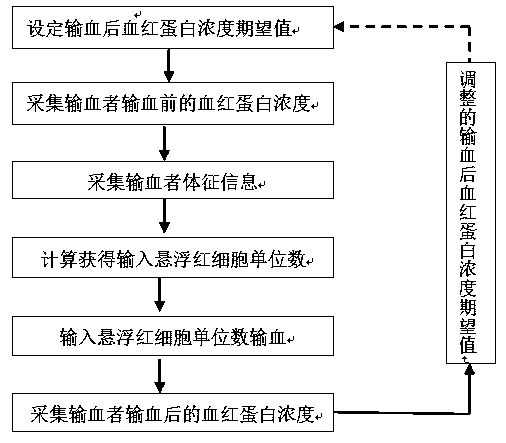A system for assessing the demand for red blood cell transfusion and evaluating the curative effect
An evaluation system and red blood cell technology, applied in the field of clinical red blood cell transfusion demand assessment and efficacy evaluation, can solve problems such as inaccurate blood transfusion volume, save blood resources, reduce pain, and reduce blood transfusion risks.
- Summary
- Abstract
- Description
- Claims
- Application Information
AI Technical Summary
Problems solved by technology
Method used
Image
Examples
Embodiment 1
[0040] Embodiment 1 (non-operative blood)
[0041] use as figure 1 The evaluation method of blood transfusion volume shown in the clinic evaluates the blood transfusion volume of the patient. Patient Li XX, measured hemoglobin concentration (Hb value) was 50g / L, entered basic information: age 70 years old; weight 60kg, diagnosed with Alzheimer's disease, body temperature 36.5°C, heart rate 80 beats / min.
[0042] (1) Set the expected value of hemoglobin concentration after blood transfusion: 50g / L
[0043] (2) Measure or record the hemoglobin concentration of the recipient before blood transfusion: 50g / L
[0044] (3) Measure or record one or more information of blood recipients selected from blood oxygen saturation, blood perfusion rate, heart rate, age, weight, basic disease information, body temperature, and oxygen concentration: age 70 years old; weight 60kg, diagnosed with Alzheimer's disease, body temperature 36.5°C, heart rate 80 beats / min
[0045] (4) Calculate the n...
Embodiment 2
[0051] as per figure 1 According to the method shown, according to Huaxi Perioperative Transfusion Indication Score (POTTS), the blood transfusion requirements of patients with symptoms in Table 1 can be adjusted according to the expected value of hemoglobin after blood transfusion as shown in Table 1:
[0052] Table 1 Adjustment of expected hemoglobin value after blood transfusion
[0053]
[0054] The expected value of hemoglobin concentration after blood transfusion for adults can be increased to 100g / L at most, and the expected value of hemoglobin concentration for the elderly can be increased to 120g / L after blood transfusion; the expected value of hemoglobin concentration after blood transfusion for children can be increased to 140g / L.
Embodiment 3
[0056] for figure 1 The system for evaluating the clinical blood transfusion volume includes a data collection module, a data storage module, a data processing module, and a data display module; the data collection module includes a data monitoring module and / or a data entry module for collecting and / or Or input hemoglobin concentration, blood oxygen saturation, blood perfusion rate, age, weight, basic disease information, body temperature, heart rate, oxygen concentration, effect evaluation information; the data storage module is used to store the information of the data collection module The data processing module is used to compare the hemoglobin concentration after blood transfusion and the expected value of hemoglobin concentration, and select blood oxygen saturation, blood perfusion rate, age, weight, basic disease information, body temperature, heart rate, oxygen inhalation, and effect evaluation information The data of the composed group is connected to obtain the expe...
PUM
 Login to View More
Login to View More Abstract
Description
Claims
Application Information
 Login to View More
Login to View More - R&D Engineer
- R&D Manager
- IP Professional
- Industry Leading Data Capabilities
- Powerful AI technology
- Patent DNA Extraction
Browse by: Latest US Patents, China's latest patents, Technical Efficacy Thesaurus, Application Domain, Technology Topic, Popular Technical Reports.
© 2024 PatSnap. All rights reserved.Legal|Privacy policy|Modern Slavery Act Transparency Statement|Sitemap|About US| Contact US: help@patsnap.com









